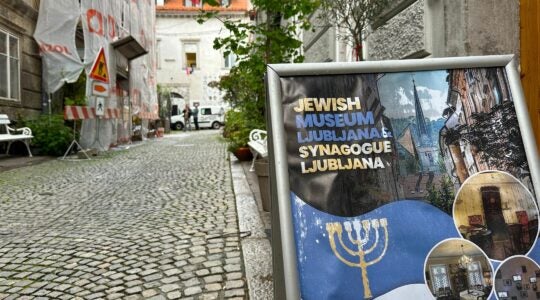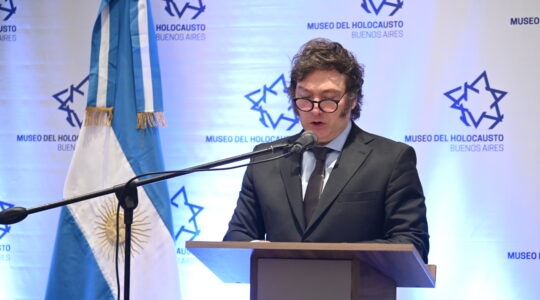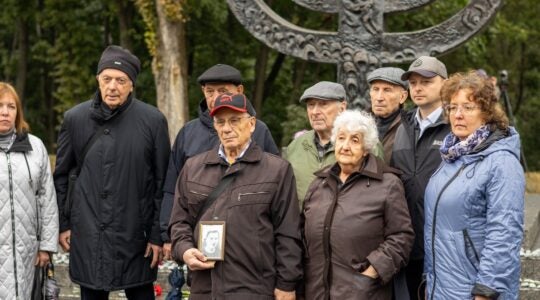MOSCOW (JTA) – Pacing the pale concrete floor of the construction site, his words ricocheting between bare concrete beams, Rabbi Alexander Lyskovoi is barely able to contain his excitement.
After nearly 15 years of activity but without a building of its own in Moscow, Russia’s Reform Jewish community finally has secured a permanent home in the Russian capital. The new building constitutes a key benchmark in Reform Judaism’s quest to expand in the former Soviet Union.
“It’s a huge victory and a huge step for Russia,” Lyskovoi says, a wide smile beaming from behind his closely cropped grey beard.
Although the space won’t be open until renovations are completed in the fall of 2008, the building’s purchase caps a year of significant growth for the World Union for Progressive Judaism. It may also be a sign that Reform, long considered an also-ran in the Jewish constellation of the former Soviet Union, is gaining steam in a country where religious Judaism is dominated by Orthodoxy.
The Moscow center is the second major purchase in Russia this year for OROSIR, the acronym by which Russia’s Reform movement is known. In June, the first new Reform synagogue built in the former Soviet Union was dedicated in St. Petersburg. A massive structure near the mooring of the famous battleship Aurora, the Sha’arei Shalom Synagogue has provided a significant boost to Reform morale here.
Reform’s worldwide movement, the World Union for Progressive Judaism, is hoping the Moscow center will prove an even more salient symbol of Reform’s surge in Russia.
“We are growing,” Lyskovoi said. “We are more adult.”
Purchased for some $2.75 million, the space represents an enormous expenditure for the WUPJ, whose entire annual operational budget in Russia is under $3 million. Another $500,000 will be needed to complete construction before the space can be used. Two large private donations enabled the purchase.
Located on the third floor of an ultra-modern office building in the same Marina Roscha neighborhood that houses the sprawling headquarters of the Chabad-led Federation of Jewish Communities of Russia, the fledgling space is still a blank slate, its walls and floors bare.
Plans for the center include a permanent synagogue, staff offices and facilities to house OROSIR’s many clubs and youth programs, which now are scattered about the city. Lyskovoi and others hope that having a central location will greatly increase membership and activity among their constituents.
Still, located at least a 15-minute walk away from the nearest metro station in a neighborhood that’s not quite downtown Moscow — though a recent WUPJ news release would beg to differ — the center is hardly the prime central location for which Russia’s Reform leaders had been searching.
But given Moscow’s soaring real estate market, the compromise location was the best the WUPJ could get, according to the president and CEO of Century 21 Real Estate in Russia, Nuri Katz, who was involved in the deal.
Since the collapse of the Soviet Union, Reform Judaism has struggled in Russia while the Chabad-led federation has thrived, thanks in part to strong political connections and committed overseas donors.
A decade and a half ago, when the post-Soviet government was making the first wave of restitutions to religious communities, Rabbi Zinoviy Kogan, now a spokesman for the Orthodox umbrella group KEROOR, received the historic shul on Bolshaya Bronaya Street, in the heart of Moscow.
At the time, Bronaya was a Reform synagogue, but then Chabad emissaries from the United States and Israel arrived, and although the details remain murky, city authorities somehow shifted ownership of the shul to Chabad. Thus began Reform’s struggle for a Moscow home.
Despite a sense that history finally seems to be turning in Reform’s favor, Lyskovoi is cautious about suggesting his movement can compete with Chabad, which has been enormously successful in the former Soviet Union.
“We cannot compare our budgets. It’s not a competition at all,” Lyskovoi said. “We provide this building, these services, these activities for people who need it — that’s all.”
JTA has documented Jewish history in real-time for over a century. Keep our journalism strong by joining us in supporting independent, award-winning reporting.





